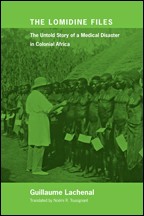- "All the villagers, women and children included, gathered, as they did every year, for their injection of Lomidine. The preventative administration of Lomidine to entire populations, then called "total Lomidinization," was a priority and a source of pride for this postwar colonial health services. The technique's efficacy was unprecedented: a single injection of Lomidine conferred protection for several months against infection by trypanosomes, the parasites that cause sleeping sickness… for the first time, eradication was within reach." (p. 1)
However, amidst the scientific certainty, and millions of injections, it was later learned that Lomidine had no preventative effects at all. What brought halts to the campaigns, however, was not a change in scientific opinion, but a series of disasters. Such as: "…A catastrophe was looming, and the diagnosis was soon obvious: the shot of Lomidine had caused a bacterial infection that progressed to gas gangrene, spreading from the buttock to the rest of the body, leading to swelling and bursting in affected tissues" (p. 2). "This may be why rumors about the campaigns were so worrying to colonial authorities, as if the irrationality and ignorance of which Africans were being accused might, in fact, be a projection of the doctors' enthusiastic and amnesic foolishness" (p. 183).
Guillaume Lachenal's "The Lomidine Files: The Untold Story of a Medical Disaster in Colonial Africa" (2017 translation by Noémi Tousignant) tells the story of Lomidine. A wonder drug scientists were fully convinced worked, only later to learn it did not work as thought. The author explains: "This book is a biography of Lomidine. It traces this medicine's trajectory from its first trials during the Second World War, when it was introduced as a miracle cure for sleeping sickness, to its abandonment in the late 1950s, when a series of incidents in Gribi and elsewhere brought Lomidinization campaigns to a grinding halt. My broader aim, however, is more ambitious: by selecting as a historical object this white powder, a power injected more than ten million times in Africa during the 1950s, I am experimenting with a novel form of inquiry into the relation between medicine and colonialism" (p. 2).
The book explores medicine for colonialists and colonized (p. 90). The testing of "native volunteers" by exposing them to tsetse flies "every two or three days" for more than a year (p. 30). Blaming medical error and scientific fallacy on the colonized (p. 157). In this regard, it provides a wealth of insight into the colonial projects. The book also provides a wealth of insight into scientific "certainty" more broadly (p. 173). However, the book could have done much better in speaking about the spread and control of sleeping sickness. While this did not need to be the focus of the work, readers are left wanting slightly more information on the bigger picture of the disease.

